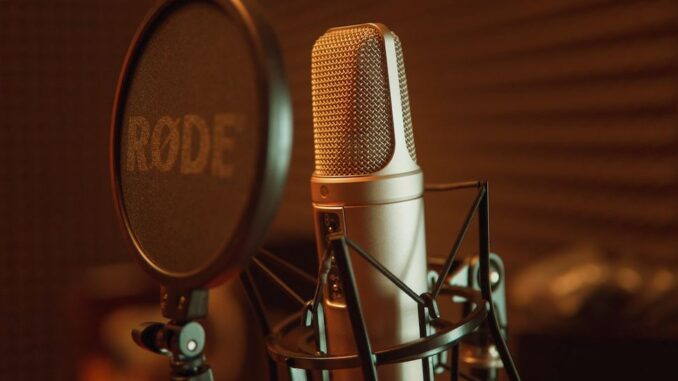
Although making your own recording studio is hard and requires money, it doesn’t mean you have to nurture the project for years and wait for millions to accumulate.
To start down the path of a record producer, you can start small. In fact, you only need eight basic elements to get started. Already with this machine, you’re well on your way to producing radio-quality tracks, arranging, and recording instruments.
Necessary equipment
A home studio is not as expensive an undertaking as it might seem. Usually people spend a lot more on equipment than they need, although it would be much more logical to invest in skills and abilities. The golden rule says: before you invest in a new staf, you need to thoroughly know what you are working on now.
Generally speaking, a basic home studio consists of eight elements that make up its foundation.
Basic home studio equipment:
- Audio Interface
- Microphone
- Microphone cable
- Microphone stand
- Pop Filter
- Headphones
- Monitors
- Soundproofing
- Computer
If you have this equipment, there is technically nothing stopping you from producing good quality tracks. And, to be fair, even on this list, not everything must be purchased. For example, you can do without sound isolation and monitors at the beginning and learn to mix in headphones. Let us touch each category of equipment in more detail:
1. audio interface
The common choice for home recording is USB audio interfaces because of their convenience and widespread use. You need an interface to which you can connect a microphone, speakers, a line source (like a guitar) and headphones.
First and foremost, check out the Focusrite line of products. The leaders in the home recording sector have released the third generation of the Scarlett range, with an emulation of Air microphone preamplifiers and a large package of complete plug-ins. The basic model, with which you can record vocals, guitar and compose material in a sequencer in excellent quality – Scarlett 2i2.
If you need fundamentally more channels (say, for recording drums or vocal polyphony), take a closer look at the Scarlett 18i8. More texts
Interfaces like these will put an audio card out of the question for a long time to come. And when your skills and demands lead to the purchase of more serious equipment, look for a device with a more professional preamp and DAC/DAC. One option is the Universal Audio Apollo Twin X Duo, which will just meet your increased requirements.
2. Microphone
The first thing you should buy for your home studio is a condenser microphone with a cardioid directional pattern. The fact is that microphones with such a diagram do not pick up sound on the sides and behind the diaphragm, and most of all tolerate not the most perfect in terms of acoustics of the room.
Speaking of types, you’ll want a condenser microphone with a large diaphragm. Such mics are great for recording vocals, acoustic strings and other acoustic instruments.
As an example, sE Electronics X1 S is a universal condenser microphone: it is suitable for almost any type of tracking and is good for vocal recording. As the second microphone it is worth to buy dynamic microphone: it will be useful for recording guitar cabinet signal, hand percussion/drums and will also be useful for vocals recording. In this case, we recommend starting with the classic Shure SM57. It’s hard to think of a microphone that is more common and used in more studio/concert situations than this one.
3. microphone cables
Don’t forget to purchase a balanced XLR cable. That said, don’t be too fanatical about buying the most expensive cables possible. A whole working medium priced wire will be quite enough. Good working options are SZ-AUDIO AP-2114-10M, Superlux SFM2.5FM, NordFolk NMC9/3M, Cordial CCM 5 FM.
4. Microphone stand
The same principle applies to stands. Get one microphone stand for each microphone. Keep in mind, stands do wear out over time. If you save money, you run the risk of replacing the stands every few months. We suggest a few options for you to choose from: Superlux HM48B, RODE PSA1. They will serve you well for several years and will not collapse at the most inappropriate moment together with your microphone on the floor.
5. Pop Filter
A must for recording vocals if you do not want extraneous sounds, excessive explosive consonants, breathing sounds and other noise to get into your recording. Pop filters are inexpensive and invaluable. Examples of good and affordable pop filters are SZ-AUDIO MS-15, Superlux MA-91B, MXL PF 001.
6. Headphones
Here you have to choose between closed and open headphones.
The closed headphones are needed for monitoring on the recording (or mixing on set).
The open earphones are for mixing in the studio.
The first pair we advise to buy closed headphones, for example Beyerdynamic DT 770 PRO 250 Ohm or more budget variant Superlux HD-662. You will be able to record material, use them outside the studio and mix (the main thing is not to overdo the volume and use a reference during mixing). The models have a fairly neutral AFC, which will allow you to reliably transmit material for mixing.
7. Monitors
Although you can get started in your home studio without them, it’s hard to really learn how to edit without monitors. It is the lot of experienced sound engineers who can only use headphones. And they still need to check the mix on monitors.
Monitors are obviously designed for work, not for home listening, so they should be as flat and neutral as possible. Therefore, different hi-fi speakers will not do – they color the sound. Among available ones we recommend you to listen to two-way Yamaha HS8. It’s worth mentioning that monitors of this size are suitable for rooms with sound insulation. If this is not your case or you are based in a small room, consider Yamaha HS5.
Regarding monitors it is important to remember that it is much more important not the particular brand of the purchased devices, but how thoroughly you studied the sound of your monitors and learned to work with them. We recommend buying stands or stands for a pair of monitors.
And of course you should pay attention to the type of monitors you are going to buy – you need active monitors, i.e. with built-in amplification.
8. Soundproofing
In this case we are talking about acoustic panels which regulate the natural reverberation of the room you are sitting in.
Recording and mixing require a room that is as neutral in sound as possible. That way you take away the extraneous coloration of the sound.
Fiberglass panels are a great option.
9. Computer
Any more or less modern computer will do for starters. For 2019, the power of even relatively modest devices is enough to record without interference, noticeable delay and clipping.
But if you plan to work with large projects with many channels, you will need a machine with a powerful processor and at least eight gigabytes of RAM.
As for the operating system, there is not much to choose from – Linux-like systems remain exotic. If the budget is not constrained, get a Mac, the Apple ecosystem still holds the mark among professionals in the media and entertainment industry.
The main difference between MacOS and Windows is the built-in Core Audio codec, which minimizes latency in audio streaming. Unfortunately, Windows has no default tools for similar functionality, so the most common is to use the third-party ASIO protocol from Steinberg. In general, this is all the essentials you need for your home studio.
